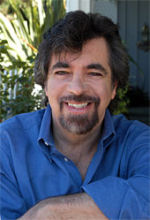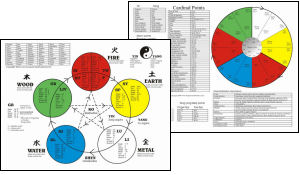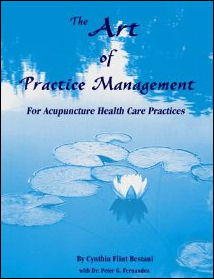Acupuncture & TCM Articles

Neil R. Gumenick is the founder and Director of The Institute of Classical Five-Element Acupuncture. Neil is a Worsley certified advanced teacher of Classical Five-Element Acupuncture and a practitioner with over 27 years of private practice experience. Neil holds three degrees from the College of Traditional Acupuncture (U.K.), and he participated for 10 years in the Master Apprentice Programô, led by Profs. J.R. & J.B. Worsley. Neil has taught at the USC and UCLA Schools of Medicine, the Worsley Institute of Classical Acupuncture, the Traditional Acupuncture Foundation, California Acupuncture College, Santa Barbara College of Oriental Medicine, and Pacific College of Oriental Medicine. He has been a Professor at Emperor's College of Traditional Oriental Medicine and SAMRA University of Oriental Medicine. Neil is co-author of The Art of Practice Management for Acupuncture Health Care Practices
Practitioner/Patient Rapport:
Developing Rapport with the Emotion of the Water Element, Part One of Two
The Skills of Diagnosis and Rapport
By Neil Gumenick, MAc (UK), LAc, Dipl. Ac
For thousands of years, Classical Five-Element acupuncturists have used the diagnostic indicators of color, odor, sound and emotion to determine the underlying elemental imbalance, or Causative Factor, of a patient's disease.
The moment one of the Five Elements (Fire, Earth, Metal, Water, Wood) becomes imbalanced, the affected element will manifest its specific corresponding facial color, body odor, vocal sound and emotion. In time, the imbalance will spread to affect other elements and symptoms can thus appear anywhere, but the four primary correspondences of the originating Causative Factor do not change. Though they will vary in intensity with the degree of imbalance, they do not change. If we perceive three of the four primary correspondences pointing to the same element, we know the Causative Factor, the focus of our treatment.

In order to perceive these correspondences, we must awaken our senses in order to see, smell, hear and feel. This takes time, practice and skilled guidance. The key to opening our senses is getting out of our heads and into our bodies, our sensing meters. Rapport is the means to accomplish this. It is the arc that connects us to our patients. When we are at one with our patients, we perceive directly who they are and what they need in body, mind and spirit. Coming from our senses (and not our intellects), we can perceive with our whole selves, which is the only way to perceive the whole of another.
The inappropriate expression of emotion - either by its excess or its lack - reveals the imbalanced element. Every person has the need to express each of the five emotions (joy, sympathy, grief, fear and anger) in a given set of circumstances. The task of the practitioner is to note how the emotions express. If an emotion is expressed when it is uncalled for, or fails to express when it should, we sense this incongruity as a "jarring" within ourselves. When we are continually "jarred" by the same incongruity, we know we are perceiving the Causative Factor Element in its cry for help.
Fear: the Emotion of the Water Element
Fear is a necessary emotion, arising from the nature of the Water Element. Every organ and function in our body depends on the reserves of energy and power stored in the Bladder and Kidney, the officials of Water. Everything that nourishes; protects; cleanses; lubricates; grows; eliminates; or otherwise moves within us does so by the grace of water. Without a ready supply of water to draw upon, any and all of the body's functions would be threatened. Like a battery run down, everything dependent on the battery's stored energy would begin to fail.
In nature, we can see that without a supply of water, nothing can sprout and grow in spring, flower and blossom in summer, and ultimately be harvested in late summer. Thus, we can understand the relationship of the emotion of fear to the Water element. With no harvest in sight, the future itself is a terrifying prospect, unknown and uncertain. With no reserves, no new beginning is possible. Our very survival is in doubt. Water, associated with the season of winter, is a time to rest, recharge our "batteries," and conserve our energy within. The landscape is frozen; outward signs of life have disappeared. People who live and depend on the land know that if there are no reserves to draw on, they simply cannot survive a winter.
As I write this article, Americans face the fear of war, not only on foreign soil, but also with the ongoing threat of terrorism at home. This is a fear almost beyond comprehension, as evidenced by Americans in the first days and weeks after 9/11. With all that we have done to provide security and safety for ourselves, our families and our country, there is the growing realization that everything on which we have come to depend can be suddenly taken away.
With a good measure of certainty, we trusted the future, even though we knew we could not really know it. With confidence, we set our alarm clocks and saved for our children's college. Now, though we continue to set the alarms and save our money, our trust has been compromised. We see the future as uncertain and we are afraid of what we cannot know or depend upon. Reflecting on 9/11 and the subsequent fears it engendered, we can gain understanding of the fear that is associated with the Water element. Many of our patients have lived with such fear, their inner personal equivalents of 9/11, every day of their lives.
The terror of the Water element in imbalance arises from the internal feeling of not having enough in reserve to meet the demands of life. Even the smallest worries are perceived as catastrophic in their imagined outcomes. It is akin to having no money in the bank, no "cushion" against the unexpected. Thus, one may be afraid to answer the phone or the knock at the door, afraid to go out socially, afraid to make eye contact or interact with others. Like children afraid of the dark and imaginary monsters under the bed, or students terrified of upcoming exams, the basis of the fear is an internal feeling that what one is or what one possesses is simply not enough to meet the unknown future. The end of a cycle; a relationship; a career; or of life itself, can come at any moment, and there is often nothing we can do to stop it.
Every moment of our lives, we confront the unknown to some degree. In truth, we do not have total control over the future. Those who cannot accept that reality are in a constant state of anxiety. Rather than entering the flow of life, those in whom Water is imbalanced and fear has become excessive tend to withdraw in paralysis. As patients, they continually need reassurance that everything will be okay, that they will get better, that we have successfully treated others with the same problem, that their ache or pain is not life-threatening.
In panic, they may run from one doctor or one system of medicine to another. Yet for such people, there is never enough reassurance to dispel their imaginings of impending danger. Their continual need for reassurance, far in excess of any real degree of danger, jars our senses as inappropriate. It is precisely because of the imbalance in the Water element that such people perceive everything to be a threat for which they are inadequately prepared. Their instinct for self-preservation runs wild and creates, to some degree, a perpetual state of alarm.
On the other extreme are those who deny fear. Whether through bravado or numb indifference, the Water-imbalanced patient can suppress this emotion so as to appear immune to fear. Instead of expressing fear and concern in appropriate circumstances, we may see patients who embrace danger: perhaps refusing to obtain or follow sound medical advice, dismissing alarming medical evidence as irrelevant, being unwilling to make necessary lifestyle changes, engaging in dangerous sports and activities, living life in the "fast lane," as if to say, "I'm invincible. Nothing can happen to me." Such patients might actually seek "alternative medicine" as a mechanism of denying the fear of what a Western physician might discover.
The Emotional Gifts of Water
Fear is a necessary emotion. It keeps us from being reckless and careless in the face of danger and uncertainty. It allows us to exercise due caution and conserve our resources for the long haul of a lifetime, spending only the amount of energy necessary for any given activity. As the storehouse of our deepest and richest reserves of energy, Water grants us the stamina and endurance to stay the course and survive even the most demanding and challenging of circumstances. Determination and willpower are the gifts of the Water element.
We marvel at the tireless acts of self-sacrifice and heroism of police officers, firefighters, paramedics and rescue workers at the scenes of disaster. We have heard of mothers who, in the attempt to save their children, have single-handedly lifted the weight of an automobile. Even you and I, in any given day, are called on to give of ourselves in the service of sick people who are placing their bodies, minds and spirits in our hands. Where do we find the strength to give when there is nothing more to give? We tap into the reservoir of energy that is the gift of Water.
A Reassuring Appearance
One major reassurance-builder is the appearance of your office and yourself. In our culture, people expect a high degree of professionalism from doctors. The office, therefore, should be immaculately clean, tidy and organized. This does not necessarily mean a high-rise medical suite in a glass and steel building or a cold, white clinical atmosphere. It does mean that however humble the office, it should be clean, comfortable, and clearly show that it is a medical office (as opposed to a bedroom or living room, for example) and be treated as such.
With regard to personal appearance, I recommend being as mainstream and professional-looking as possible. For men, wear a dress shirt, slacks and dress shoes at minimum; for women, a skirt or slacks and blouse (or sweater, jacket, as appropriate) dress shoes, etc. If white lab coats are worn, they should be immaculately clean and pressed. Standards of professional hygiene (hair, nails, etc.) are essential. All of this is reassuring to patients.
In the Treatment Room (and Before)
In the case of a first patient visit, there are numerous occasions that can call our attention to the state of a patient's Water element and the emotion of fear. The fact of being at the office of an acupuncturist is in itself a source of a degree of appropriate fear of the unknown. "What is going to happen? Will it hurt? How many needles will I get? Where are they going to stick me? What will they find wrong with me? Will this help? I must be crazy to be doing this. This is really weird. I hope nobody finds out." These are just a few of the internal conversations that can go on in the minds of patients before they ever set foot in the treatment room.
I personally recommend a treatment room with lots of natural light and easy access to the door. That way, patients do not feel trapped. The practitioner sitting behind a great desk places a barrier between him/herself and the patient, and also places the patient in a psychologically inferior position. I recommend the practitioner and patient begin the first visit sitting in equal chairs side-by-side, angled slightly toward each other. Being seated directly facing the patient can be too confrontational and intimidating for some patients.
The suggested arrangement allows the patient to choose and adjust as he or she wishes, moving closer or farther away, making eye contact or not, giving or receiving physical contact or not, and so on. How the patient responds to your adjustments is immensely useful diagnostically. For example, if you offer a reassuring touch on the patient's shoulder, with your words, the effect is greatly enhanced. If the patient tenses or pulls away from such contact, you know to allow more space for the time being. You can re-test their response at a later time during the treatment, as well as on subsequent visits, and may find that your touch is welcomed. This is evidence that you are gaining rapport and that your treatment has reached levels deeper than the physical.
If your reassuring touch, accompanied by a reassuring voice, body language and facial expression causes a fearful patient to relax and soften, you have evidence that this is the approach they need. You have discovered the method through which more rapport can be established, and you can return to it. Your message must convey one integrated message. It must say, in all ways, "I'm here with you. I hear you and understand you, and I am going to help and support you. You are not alone in this." When a parent goes to a frightened child who awakens with a nightmare, the parent does not have to "think" about how to reassure the child. It is elicited by the very nature of the situation. It is within all of us as caretakers to respond to fear exactly in this way. It is a sensory, instinctual reaction. The more we awaken the emotions of the Five Elements within ourselves, the more responsive we will be to the wide array of emotional needs of our patients.
These qualities of adaptability and empathy, too, are gifts of the Water element. Like Water, which takes the shape of whatever contains it, filling every hollow and yielding to every protrusion, our empathy lets us travel the length and depth of a patient's psyche. The Water element allows us to find within ourselves the place of internal stillness and quiet, where we are free from striving, effortlessly reflecting, available to respond to whatever comes. The late t'ai chi master, Patrick Watson, called this "listening ability," being so still and receptive that we can feel and know directly where balance and imbalance exist and respond with exact precision. Emotional imbalance is perceived by its inappropriateness, the "jarring" sensation referred to earlier. We perceive and respond to the "jarring" with our whole selves; we notice the patient's response. Did things smooth out? Did the patient like it or not? If not, we shift gears and try another direction. When oneness is achieved, we feel it, not intellectually, but from our senses.
 
The Art of Practice Management for Acupuncture Health Care Practices
What you will find in this book is a specific, comprehensive approach that gets to the root cause of success in practice.
This new book presents acupuncture practice as art from the standpoint of centering, qi, and wholeness. It builds on the premise that practices succeed from bridging inner and outer aspects of the self. It is an inquiry into the self and addresses clear understandings and approaches to reputable patient care and practice qi. It brings in the five elements and work with the seasons of practice from training and start-up to growth, stability, expansion and transformation. The authors artfully bridges the essence of both patient and practitioner well-being without excluding the practicalities of financial well-being. This book very specifically and extensively shows how the different parts of practice nourish and feed one another and are interdependent on one another for the qi to flow synchronistically.
It explores the dual nature of procedures that work and those which do not in acupuncture health care practice, returning again and again to the delicate balance of practicality and spirituality.
|
